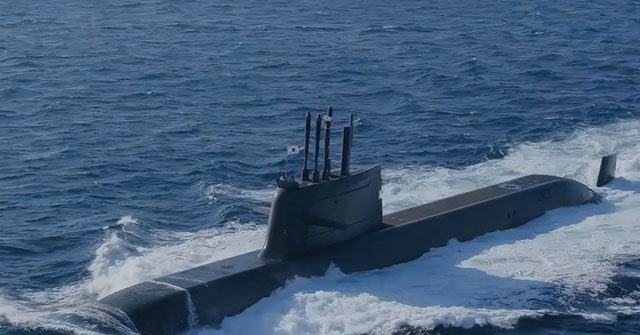Three South Korean companies, acting with the support of their government, have presented Canada with an unsolicited $20 billion plan to upgrade its submarines, artillery, and armored vehicles.
CBC News reported Monday that the proposal was an unusual example of coordination between normally competitive South Korean corporations and the government in Seoul. The proposal was crafted and presented on the initiative of the South Koreans, rather than being requested by the Canadian government.
The full price tag for the deal could range as high as $25 billion, depending on exactly how much it costs for Hanwha Ocean and Hyundai Heavy Industries to replace Canada’s aging submarine fleet and build new submarine maintenance facilities.
Canada has the largest coastline of any country in the world, but it currently relies on a fleet of four aging Victoria-class long-range submarines, which entered service in the early 2000s. Last July, the government of former Prime Minister Justin Trudeau expressed interest in upgrading its sub fleet with 12 newer non-nuclear subs. One of the key desired features of the upgrade sub fleet was better capability for maneuvering under ice for deployments to the Arctic.
South Korea’s KSS-III design, the Dosan Ahn Changho-class of submarines, has the capabilities Canada is seeking. The KSS-III has the endurance needed to sail under ice, it can launch land-attack cruise missiles, and it is much stealthier than Canada’s existing subs.
CBC reported that Hanwha and Hyundai gave Canada a “detailed, joint presentation” that promised to deliver four new submarines by 2035. Canada’s current upgrade plan envisioned having only one new sub operational by that date.
The third South Korean company involved in the proposal was Hanwha Aerospace, sister company to Hanwha Ocean. The aerospace company added a billion-dollar proposal to upgrade Canada’s artillery and armored vehicles – two product lines in which South Korean companies have become world leaders, offering high-level performance at discount prices.
“We do not think of this as a single, one-time deal between two countries. It’s not a transaction for us. If we do succeed in making the sale, then we are going to try and give our effort toward strengthening the capabilities of Canada’s defense industry, as well as furthering defense co-operation,” South Korean Deputy Defense Minister Hyunki Cho told CBC.
The opportunity for South Korea to establish such a relationship with Canada was created by U.S. President Donald Trump’s tariffs and disparaging comments about America’s northern neighbor. The once-moribund Liberal Party of Canada, all but given up for dead in the latter days of Trudeau’s administration, came roaring back to win another term in power in last week’s election.
Trudeau’s successor, Prime Minister Mark Carney, made it clear that Canada would look for alternative military suppliers as relations with the United States deteriorated. One of the most politically contentious projects that Canada could withdraw from is the F-35 fighter program, to which Canada committed $19 billion.
After he was reappointed on Friday, Canadian Defense Minister Bill Blair said he was looking at alternatives to the F-35. Blair suggested Canada is essentially locked into purchasing the first 16 F-35s, but could cancel the remainder of its order. He hinted that Sweden’s Saab Gripen F-39, the leading competitor when Canada chose the F-35, could replace the rest of the jets America was supposed to provide.
According to CBC, Korean Aerospace Industries (KAI) has suggested its F-50 fighter as another alternative, although it did not add a detailed proposal to those submitted by Hanwha Ocean, Hanwha Aerospace, and Hyundai Heavy Industries.
The F-50 is South Korea’s first indigenously produced light attack aircraft. It was designed to be compatible with the American-build systems South Korea was heavily dependent upon. The KAI plane is not as sophisticated as the F-35 and lacks its stealth characteristics, but it is much less expensive to produce.
South Korean analysts told CBC they felt their companies stood a decent chance of winning Canada’s business because, no matter how angry the Canadians might be at Trump, they will have serious misgivings about entrusting their security needs to the fragile supply lines of Europe.
The South Koreans feel they still have some untapped production capacity, thanks to former President Yoon Suk-yeol’s determination to build his country into a world-class arms supplier, while the Europeans are having difficulty keeping Ukraine supplied against Russia. The game changed when Poland began looking to South Korea instead of European companies for tanks and howitzers in 2022. Other European and Asian buyers soon followed suit.
“Prior to the large contract signed with Poland, Korea’s reputation as a defense exporter was not that large. However, with the signing of a massive contract with Poland and throughout the process of implementing these contracts, many countries have found that Korea is able to supply quality products in a timely manner,” South Korean defense acquisition minister Seok Jong-gun told CBC.
Canadian Global Affairs Institute President Dave Perry said Poland’s success at rebuilding its military with South Korean hardware has been noticed in Ottawa.
“They’ve got a track record already at being able to provide huge amounts of equipment in very short order. The Canadian Armed Forces is at the point where we have really serious operational readiness deficiencies. We do need to look for options that can fulfil at least some of our acquisition needs quickly,” Perry said.
Read the full article here
